1) MQL4 is a strong typed language ( declaration precedes any use of a variable )
+ MQL4 has a historical feature of a number "normalisation"
An assumption (cit.) "They are divided by _Point to give an integer" does not hold.
Once any number has been declared double in a source code as:
double upFractal = 0.0,
dnFractal = 0.0;
the MQL4-compiler handles these numbers forever in an IEEE-754 floating point number representation and calls particular sub-version of operations on any arithmetics operation such number is entring into. The reason is simple, double has different handling than ( New-MQL4.56789 ) float, the more than int et al. Some numbers, represented in IEEE-754, are inexact by-definition, some could remain exact ( if they happen to be some direct power-of-2 and still in it's "virgin"-state ( have not yet been spoiled by any arithmetic operation, that would introduce an un-avoidable im-precision into their binary-representatio ) ).
Why im-precision?
Why un-avoidable?
For non-virgin numbers, the binary-representation may yield into an infinitely-long description of the value. On the contrary, the storage of any value in MQL4 is restricted to { 1 | 4 | 8 }-bytes of memory-space and thus the infinite-representation is un-avoidably cut at some distance, introducing a principal im-precision , expressed by:
DBL_EPSILON ~ 2.2204460492503131e-016
FLT_EPSILON ~ 1.192092896e-07
beyond which any two numbers, represented in IEEE-754 binary-format, look to the compiled code as "equal", even if they are not principally equal, just due to the IEEE-754 format inherent im-precision.
For indeed historical reasons, double typed values ought have been always NormalizeDouble() converted, if one wants to send these to the MetaTrader Server-side processing and/or compare values on a fair ground.
2) MQL4 operations with {double | int }- typed variables
If one had declared a variable to be double, it remains double forever.
If one had declared a variable to be int, even an int/3 will remain int, ignoring the fractional products of division operation ( which sometimes causes headaches to not so carefull MQL4 coders ).
The same applied to an initial assumption above yields to a surprise, that double/double -> double even in cases, the division could be satisfactorily considered ( almost ) integer. So never assume a type conversion to happen just by the values of the operands.
For that purpose, there are two sorts of syntax-supports:
- an explicit conversion function
int( ... ) or double( ... )
- an inline typecast directive
( (int) CandleBody_1 / _Point )
Epilogue: ( ... a must read for Custom Indicator designers, where CPU-performance kills )
As said above, calling (int) NormalizeDouble(...) is a double-nonsense ( well beyond a belt + suspenders paradigm ), first, as a historically built-in function NormalizeDouble still returns double, thus providing zero-benefit from spending CPU to crunch the numbers once it still yields a double, next as the division of the number a double value of _Point is very expensive and inefficient, compared to the fact, the _Point is related to int value of Digits by a formula of 1 / 10^Digits -- so the fastest and cleanest way to do the conversion, without spending avoidable CPU-cycles, is MULTIPLICATION ...
yes,
from a computer-side of fast & efficient processing, the best is
int( MAKE_aPriceDOMAIN_VALUE_an_INT_NUM_OF_POINTs * CandleBody_1 ),
re-using a constant
int MAKE_aPriceDOMAIN_VALUE_an_INT_NUM_OF_POINTs = MathPow( 10, Digits );
